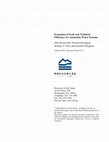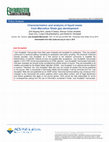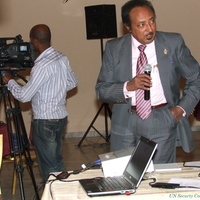Papers by Jhih-Shyang Shih

Managing the growing quantity of used electronic equipment poses challenges for waste management ... more Managing the growing quantity of used electronic equipment poses challenges for waste management officials. In this paper, we focus on a large component of the electronic waste stream- computer monitors-and the disposal concerns associated with the lead embodied in cathode ray tubes (CRTs) used in most monitors. We develop a policy simulation model of consumers- disposal options based on the costs of these options and their associated environmental impacts. For the stock of monitors disposed of in the United States in 1998, our preliminary findings suggest that bans on some disposal options would increase disposal costs from about $1 per monitor to between $3 and $20 per monitor. Policies to promote a modest amount of recycling of monitor parts, including lead, can be less expensive. In both cases, the costs of the policies exceed the value of the avoided health effects of CRT disposal.

A key question in developing effective mitigation strategies for ozone and particulate matter is ... more A key question in developing effective mitigation strategies for ozone and particulate matter is identifying which source regions contribute to concentrations in receptor regions. Using a direct approach with a regional, multiscale three-dimensional model, we derive multiple source-receptor matrices (S-Rs) to show inter- and intrastate impacts of emissions on both ozone and PM2.5 over the eastern United States. Our results show that local (in-state) emissions generally account for about 23% of both local ozone concentrations and PM2.5 concentrations, while neighboring states contribute much of the rest. The relative impact of each state on others varies dramatically between episodes. In reducing fine particulate concentrations, we find that reducing SO2 emissions can be 10 times as effective as reducing NOx emissions. SO2 reductions can lead to some increase in nitrates, but this is relatively small. NOx reductions, however, lead to both ozone reductions and some reduction in nitrat...

In this study we use datasets from the 1995 and 2000 Community Water Supply surveys to examine th... more In this study we use datasets from the 1995 and 2000 Community Water Supply surveys to examine the production costs of water supply systems. We first estimate the economies of scale in water supply by estimating the total unit cost as well as individual component cost elasticities. For total unit cost elasticity, we find that a 1% increase in production reduces unit costs by a statistically significant 0.16%. For individual component cost elasticities, we find that higher economies of scale exist in capital costs, outside costs, other costs, and materials costs; labor costs and energy costs exhibit lower but still positive economies of scale. These economies of scale may reflect production economies or suggest that larger systems are better than smaller systems at bargaining and can obtain inputs at a lower unit cost. Importantly, bargaining gains and some production economies do not necessarily depend on water systems' becoming physically interconnected.
Discussion papers are research materials circulated by their authors for purposes of information ... more Discussion papers are research materials circulated by their authors for purposes of information and discussion. They have not undergone formal peer review or the editorial treatment accorded RFF books and other publications. Contents I. Introduction.

We develop and estimate an index-based measure of expected consumer welfare under various carbon ... more We develop and estimate an index-based measure of expected consumer welfare under various carbon emissions control policies in the electricity generation sector. This approach estimates welfare effects by a somewhat less data intensive methodology than econometric approaches or more complex modeling. We include anticipated technological change in the production of renewable and nonrenewable power generation during the next two decades. We estimate welfare improvements from 2000 to 2020 as renewable energy technologies continue to be improved and gradually adopted, compared with a counterfactual scenario allowing for continual improvement of nonrenewable generation technology. We formally incorporate uncertainty. We evaluate the model under alternative carbon emissions control policies, including policies that create incentives through price mechanisms and policies that mandate the composition of the generation portfolio. We focus on three countries that differ widely in their power ...
Improved technology is often cited as a means to alter the otherwise difficult trade-off between ... more Improved technology is often cited as a means to alter the otherwise difficult trade-off between the economic burden of regulation and environmental damage. Focusing on energy-saving technologies that mitigate the threat of climate change, we find that both energy prices and financial health influence technology adoption among a sample of industrial plants in four heavily polluting sectors. Based on a model linking technology adoption to growth in aggregate efficiency, we estimate that a doubling of energy prices, after raising the growth rate to 2.1%, would require slightly more than 50 years to generate a 50% improvement in aggregate efficiency relative to the baseline forecast.

Millions of abandoned wells are scattered across the United States, causing significant methane e... more Millions of abandoned wells are scattered across the United States, causing significant methane emissions and creating a variety of health and environmental hazards. Governments are increasingly interested in decommissioning such wells via tougher regulations or direct spending, but want to do so efficiently. However, information on the costs of decommissioning wells is very limited. In this analysis, we provide new estimates of the costs of decommissioning oil and gas wells and the key drivers of those costs. We analyze data from up to 19,500 wells and find that median decommissioning costs are roughly $20,000 for plugging only, and $76,000 for plugging and surface reclamation. In rare cases, costs exceed $1 million per well. Each additional 1,000 feet of well depth increases costs by 20 percent, older wells are considerably more costly than newer ones, natural gas wells are nine percent more expensive than wells that produce oil, and costs vary widely by state. Surface characteris...

Environmental Science & Technology, 2015
Hydraulic fracturing of shale for gas production in Pennsylvania generates large quantities of wa... more Hydraulic fracturing of shale for gas production in Pennsylvania generates large quantities of wastewater, the composition of which has been inadequately characterized. We compiled a unique dataset from state-required wastewater generator reports filed in 2009-2011. The resulting dataset, comprising 160 samples of flowback, produced water, and drilling wastes, analyzed for 84 different chemicals, is the most comprehensive available to date for Marcellus Shale wastewater. We analyzed the dataset using the Kaplan-Meier method to deal with the high prevalence of non-detects for some analytes, and compared wastewater characteristics with permitted effluent limits and ambient monitoring limits and capacity. Major-ion concentrations suggested that most wastewater samples originated from dilution of brines, although some of our samples were more concentrated than any Marcellus brines previously reported. One problematic aspect of this wastewater was the very high concentrations of soluble constituents such as chloride, which are poorly removed by wastewater treatment plants; the vast majority of samples exceeded relevant water quality thresholds, generally by 2-3 orders of magnitude. We also examine the capacity of regional regulatory monitoring to assess and control these risks. TOC Art
SSRN Electronic Journal, 2010

Journal of Water Resources Planning and Management, 1994
Demand-management policy rules are sought during drought and impending drought for a water system... more Demand-management policy rules are sought during drought and impending drought for a water system consisting of a reservoir dedicated only to water supply. The creation of such rules requires solution of a nonlinear, nonseparable mathematical programming problem. A polytope search algorithm using a combination of simulation and optimization is compared to an iterative mixed integer programming method to determine the parameters of continuous demand management rules. The signal used for calling rationing is a trigger volume given in terms of months of demand (as a volume) that are needed in storage. When the sum of actual storage plus anticipated inflow is less than the trigger volume, rationing is initiated. The extent of rationing or demand reduction that is required is determined by the ration of the sum of storage plus inflow to the trigger volume. The two methodologies for parameter determination are compared using as a criteria the maximum shortage that occurs over some planning period.

Journal of Hazardous Materials, 2000
Comparative risk assessment (CRA) is a systematic procedure for evaluating the environmental prob... more Comparative risk assessment (CRA) is a systematic procedure for evaluating the environmental problems affecting a geographic area. This paper looks beyond the U.S. border and examines the experience with CRAs conducted in various developing countries and economies in transition, including Bangkok, Thailand, Cairo, Egypt and Quito, Ecuador, as well as other locations in Eastern Europe, Asia and Central and South America. A recent pilot CRA conducted in Taiwan is also considered. Comparisons are made of both the methodologies and the results across the relatively diverse international literature. The most robust finding is that conventional air pollutants (e.g., particulate matter and lead) consistently rank as high health risks across all of the CRAs examined. Given the varied nature of the settings studied in the CRAs, including level of economic development, urban-rural differences, and climate, this finding is particularly significant. Problems involving drinking water are also ranked as a high or medium health risk in almost all the countries studied. This is consistent with the results of analyses conducted by the World Bank suggesting contamination, limited coverage and erratic service by water supply systems. Beyond the major air pollutants and drinking water, the CRA results diverge significantly across countries. A number of problems involving toxic chemicals, e. g., hazardous air pollutants, rank as high health risks in the US but do not appear as consistent areas of concerns in the other countries studied. This likely reflects the so-called "risk transition" - the shift from sanitation and infection disease problems to those involving industry, vehicles and toxic substances - that often occurs with economic development. It may also reflect the greater information about sources of toxic pollutants in the U.S. For other problems, there are important differences across the developing countries and economies in transition. For example, hazardous and (industrial) non-hazardous waste issues ranked as medium or low health risks in all the countries studied, except for Taiwan where unmanaged toxic waste sites were considered to pose high risks. While the generally low ranking is consistent with the notion that few people are directly exposed to hazardous and (industrial) non-hazardous waste, it is not entirely surprising that views might be different in Taiwan, where space is so limited and population density is so high. We suggest that the wide range of findings likely reflect genuine differences among the countries studied. However, we cannot entirely rule out the possibility that some of the observed similarities (and differences) arise from the (relatively) common methodologies employed.

Journal of Environmental Management, 2003
The importance of information technology to the world economy has brought about a surge in demand... more The importance of information technology to the world economy has brought about a surge in demand for electronic equipment. With rapid technological change, a growing fraction of the increasing stock of many types of electronics becomes obsolete each year. We model the costs and benefits of policies to manage 'e-waste' by focusing on a large component of the electronic waste stream-computer monitors-and the environmental concerns associated with disposal of the lead embodied in cathode ray tubes (CRTs) used in most monitors. We find that the benefits of avoiding health effects associated with CRT disposal appear far outweighed by the costs for a wide range of policies. For the stock of monitors disposed of in the United States in 1998, we find that policies restricting or banning some popular disposal options would increase disposal costs from about US dollar 1 per monitor to between US dollars 3 and US dollars 20 per monitor. Policies to promote a modest amount of recycling of monitor parts, including lead, can be less expensive. In all cases, however, the costs of the policies exceed the value of the avoided health effects of CRT disposal.
European Journal of Operational Research, 1998
... model for photochemical air pollution control, we have to incorporate pollutant-precursor rel... more ... model for photochemical air pollution control, we have to incorporate pollutant-precursor relationships ... optimization ap-proach is not yet practical for the development air pollution control strategies due to ... stage, we generate the response surface of pollu-tant concentration as a ...
European Journal of Operational Research, 1995

Environmental Science & Technology, 2007
While the U.S. air quality management system is largely designed and managed on a state level, ma... more While the U.S. air quality management system is largely designed and managed on a state level, many critical air quality problems are now recognized as regional. In particular, concentrations of two secondary pollutants, ozone and particulate matter, are often above regulated levels and can be dependent on emissions from upwind states. Here, impacts of statewide emissions on concentrations of local and downwind states' ozone and fine particulate matter are simulated for three seasonal periods in the eastern United States using a regional Eulerian photochemical model. Impacts of ground level NO x (e.g., mobile and area sources), elevated NO x (e.g., power plants and large industrial sources), and SO 2 emissions are examined. An average of 77% of each state's ozone and PM 2.5 concentrations that are sensitive to the emissions evaluated here are found to be caused by emissions from other states. Delaware, Maryland, New Jersey, Virginia, Kentucky, and West Virginia are shown to have high concentrations of ozone and PM 2.5 caused by interstate emissions. When weighted by population, New York receives increased interstate contributions to these pollutants and contributions to ozone from local emissions are generally higher. When accounting for emission rates, combined states from the western side of the modeling domain and individual states such as Illinois, Tennessee, Indiana, Kentucky, and Georgia are major contributors to interstate ozone. Ohio, Indiana, Tennessee, Kentucky, and Illinois are the major contributors to interstate PM 2.5 . When accounting for an equivalent mass of emissions, Tennessee, Kentucky, West Virginia, Virginia, and Alabama contribute large fractions of these pollutants to other states.
Environment and Planning B: Planning and Design, 2002
We present models for the design of routes for transportation of loads that might become hazardou... more We present models for the design of routes for transportation of loads that might become hazardous or obnoxious to the population living along these routes. We take into consideration the fact that the values of the properties that are close to the roads used for the transportation may decrease as a consequence of this activity. As opposed to the traditional approach, of minimizing the population along the routes, we propose to include a compensation cost as a direct cost of choosing the routes. This compensation could include, for instance, a reduction in property tax rates. Two formulations are presented, covering different patterns of effects on property values. As an example of application of the models, we provide some computational experience.










Uploads
Papers by Jhih-Shyang Shih